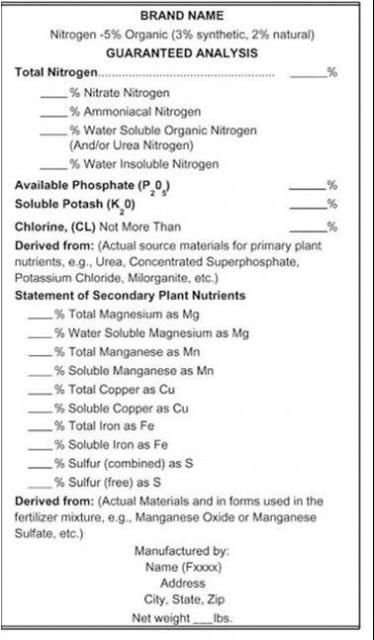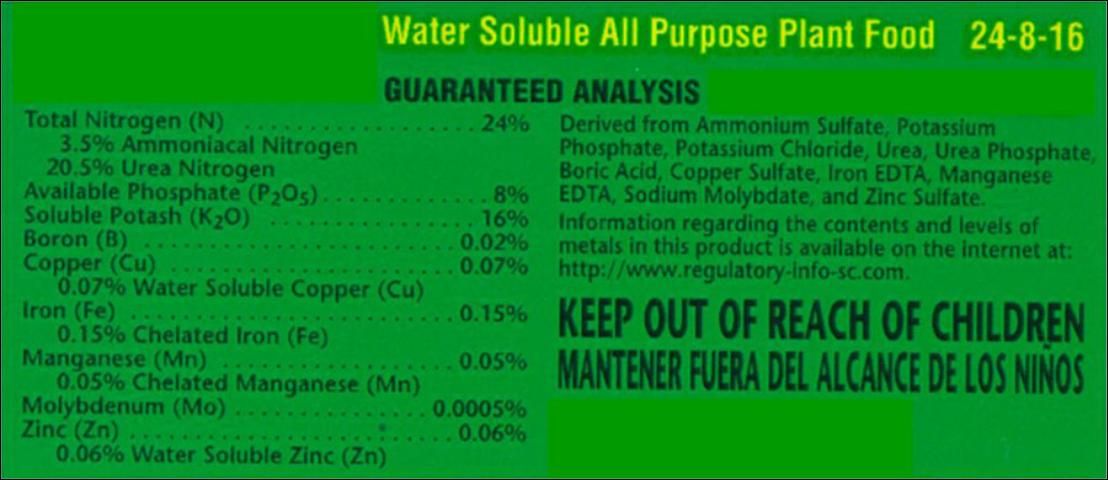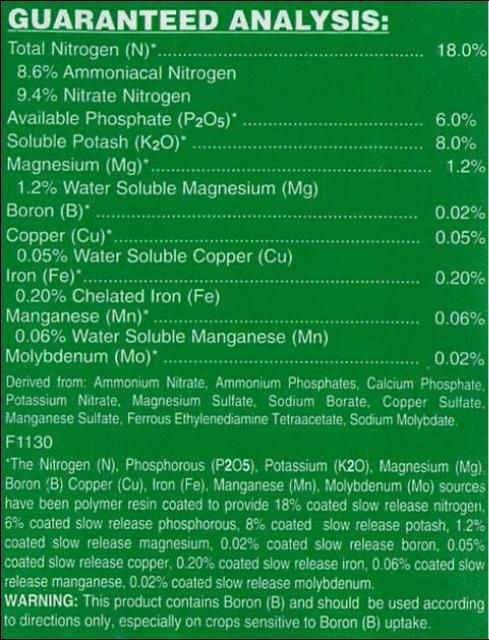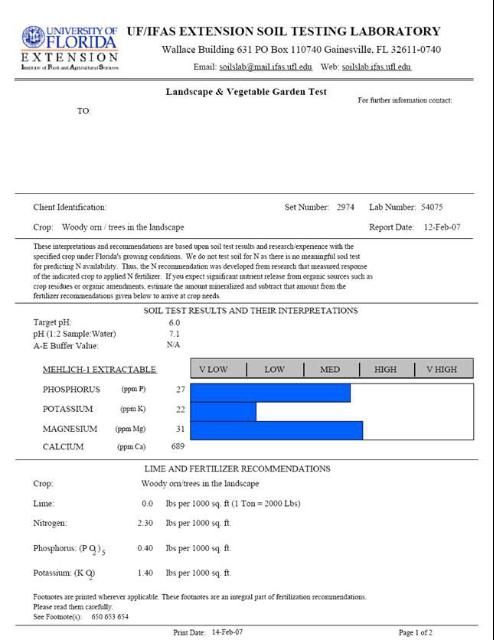This article is part of a series entitled Soils and Fertilizers for Master Gardeners. The rest of the series can be found at https://edis.ifas.ufl.edu/topic_series_soils_and_fertilizers_for_master_gardeners. A glossary can also be found at https://edis.ifas.ufl.edu/MG457.
Introduction
While the soil generally provides most of the nutrients needed for optimum plant growth, there are times when fertilizers are needed. In particular, compacted, low organic matter soils commonly found in residential landscapes often require fertilizer to provide vital nutrients needed for plant growth. Fertilizers contain one or more essential nutrients and can be applied to landscapes to improve plant growth and quality or to correct a nutrient deficiency. There are many fertilizers available to consumers at local lawn and garden centers. With so many choices, it's easy to get confused. This publication provides information about fertilizers and associated fertilizer terminology to help consumers make educated decisions when purchasing fertilizers and using them in the home landscape or garden.
What fertilizers are available?
There is no easy answer to this question because there are many different fertilizers available to the homeowner or gardener for use on landscape plants, lawns, and vegetables. Fertilizer selection will vary depending on location and store. For the most part, garden centers sell fertilizer blends, which are several nutrient sources mixed together to create a fertilizer for a specific purpose. The materials used to create the fertilizer blend are listed on the fertilizer label (Figure 1) and are identified by the words "derived from". More information on Florida fertilizer labels is available from the EDIS publication The Florida Fertilizer Label, available at https://edis.ifas.ufl.edu/ss170. Blends are created to achieve a specific fertilizer grade. The fertilizer grade is denoted by three numbers that represent the percent (by weight) of nitrogen (N), phosphorus (P), and potassium (K) in the fertilizer. For example, a 10-5-5 fertilizer has 10% N, 5% P, and 5% K. In a 50 lb bag of 10-5-5 fertilizer, there are 5 lbs N, 2.5 lbs P, and 2.5 lbs K. Additional nutrients found in the fertilizer will be listed on the fertilizer label.

In addition, most of the products sold for use on ornamental plants are complete fertilizers. In order for a fertilizer to be classified as "complete", it must contain nitrogen (N), phosphorus (P), and potassium (K). For example, an 8-2-12 blend is considered a complete fertilizer. Complete fertilizers can also contain secondary plant nutrients and micronutrients. Secondary plant nutrients include calcium (Ca), magnesium (Mg), and sulfur (S). The micronutrients, manganese (Mn), boron (B), iron (Fe), zinc (Zn), copper (Cu), molybdenum (Mo) and chloride (Cl), are required by plants in smaller amounts than the primary and secondary plant nutrients. Some fertilizer materials contain one or more of these secondary plant nutrients, which will be listed on the fertilizer label.
Fertilizers available to consumers for use in the landscape will also have variable properties depending on brand and formulation. Many fertilizer materials are inorganic, or synthetic. Examples of inorganic nutrient sources that may be used in blends include ammonium nitrate, ammonium phosphate, and potassium chloride. Other fertilizer materials are organic, including animal manures, composted materials, and plant or animal residues.
In addition, fertilizer materials may be water-soluble (soluble or quick-release), slow-release, or controlled-release. Water-soluble fertilizer material dissolves immediately in water. Once dissolved, nutrients in the fertilizer are available for uptake by plant roots. Most of the inorganic fertilizer materials are water-soluble, unless they have been formulated to be slow- or controlled-release. Slow-release fertilizers will release nutrients slowly for a period of time ranging from weeks to months. Examples of synthetic slow-release fertilizers are sulfur-coated urea and Nitroform®. Organic fertilizers also contain slow-release nutrients; however, not all nutrients in organic fertilizers are slow-release. Soil microbes must convert these slow-release fertilizer nutrients to forms that can be used by plants. In contrast, controlled-release fertilizer materials are soluble inorganic fertilizers that have been modified to allow nutrients to be released over a specific time period. In a controlled-release fertilizer, the water-soluble fertilizer materials are encapsulated in a plastic or polymer coating. Nutrients are released with time; the amount of time it takes for nutrients to be fully released depends on the nature of the coating, contact with moisture, and temperature. Typically, nutrient release from controlled-release fertilizers increases with increasing temperature and soil moisture. Examples of controlled release materials are Osmocote®, Nutricote®, and Polyon®.
Reading the Fertilizer Label
Now that you know the types of materials available to you, let's discuss how to read the label. You should always read the label thoroughly so you can make the most informed decision possible. This document will go through two examples of materials that can be purchased at a typical chain store.
Example 1: All Purpose Fertilizer
The first example is an "all purpose" ornamental fertilizer listed for use on all flowers, trees, shrubs, vegetables, and houseplants (Figure 2). The label on the box lists that is it a water-soluble fertilizer, so immediately we know that the material will dissolve in water and all nutrients will be in a plant-available form. The grade is 24-8-16, which means that, by weight, it contains 24% N, 8% P, and 16% K. It has a fertilizer ratio of 3 parts N to 1 part P to 2 parts K. (To determine the fertilizer ratio from the fertilizer grade, divide all numbers on the grade by the lowest number. For example, for a 24-8-16 fertilizer, divide all numbers by 8 to get a 3-1-2 grade.)

According to the label, 3.5% of the total N in the box is ammoniacal N (ammonium) and the remaining 20.5% is urea (3.5% + 20.5% = 24% total N). In the "derived from" statement, ammonium sulfate, urea, and urea phosphate are the sources of N. Fertilizers containing ammoniacal N or urea should be watered in to prevent N loss to the atmosphere. The sources of P are potassium phosphate and urea phosphate. Potassium is commonly listed as potash (K2O) on the fertilizer label, as seen in this example. The sources of K2O are potassium phosphate and potassium chloride.
This fertilizer also contains the following plant micronutrients: 0.02% boron (B) as boric acid, 0.07% copper (Cu) as copper sulfate, 0.15% iron (Fe) as iron EDTA, 0.05% manganese (Mn) as manganese EDTA, 0.0005% molybdenum (Mo) as sodium molybdate, and 0.06% zinc (Zn) as zinc sulfate. The term EDTA in iron and managenese EDTA indicates that the nutrient is in chelated form. Chelated forms of nutrients exist as a complex molecule containing carbon and hydrogen that have a prolonged period of plant availability. The other elements are listed as water-soluble.
Example 2: Controlled-Release Shrub Fertilizer
Our second example fertilizer is a complete shrub fertilizer with micro-nutrients (Figure 3). The label indicates that the material is polymer resin coated, indicating that it is a controlled-release material. The grade is 18-6-8, which means that, by weight, it contains 18% N, 6% P, and 8% K. It also has a fertilizer ratio of 3 parts N to 1 part P to 1.3 parts K.

According to the label, 8.6% of the total N is ammoniacal N (ammonium) and the remaining 9.4% is nitrate N, both of which are water-soluble forms of N (8.6% + 9.4% = 18% total N). In the "derived from" statement, ammonium nitrate, ammonium phosphate, and potassium nitrate are the sources of N. However, the normal quick-release action of water-soluble N is tempered by the fertilizer coating in this case. Note the statement (below the "derived from" statement) indicating the percentage of nutrients that are coated, and thus in controlled-release form. In this fertilizer, all the nutrients are controlled-release because the percentages exactly match those on the upper part of the label. The sources of P (listed in this example as Available Phosphate; P2O5) are ammonium phosphate and calcium phosphate. The source of K2O is potassium nitrate.
This fertilizer also contains the following plant nutrients: 1.2% magnesium as magnesium sulfate, 0.02% boron (B) as sodium borate, 0.05% copper (Cu) as copper sulfate, 0.20% iron (Fe) as ferrous ethylenediamine tetraacetate (EDTA), 0.06% manganese (Mn) as manganese sulfate, and 0.02% molybdenum (Mo) as sodium molybdate. In this case, only the Fe is in a chelated form, the rest are water soluble (but are all coated and therefore controlled-release).
Choosing a Fertilizer
Before you decide to use a fertilizer, you should have your soil tested. Most UF/IFAS Extension offices offer a pH test, while the UF/IFAS Extension Soil Testing Lab (http://soilslab.ifas.ufl.edu) offers tests for pH, lime requirement, P, K, and Mg. (For more information about soil testing and how to take a soil sample, see Soil Sampling and Testing for the Home Landscape or Vegetable Garden, https://edis.ifas.ufl.edu/ss494). The soil pH test is sufficient if you plan to use a complete fertilizer. This is because complete fertilizers are usually applied to meet the N requirements of plants, and N rate recommendations are based on research on plant response to N fertilizer rather than the amount of N measured in a soil sample. However, the results of a full soil test will help you decide what level of P and K, if any, will benefit your plants.
An example of the soil test results for woody ornamentals growing in the landscape is shown in Figure 4. (Before selecting a fertilizer, it is important that you read the entire soil test report, including the footnotes. The footnotes will provide important information about application methods and rates.) This sample soil test report indicates that plants would respond to applications of P and K. However, more K is needed than P.

In most cases, the complete fertilizers available to consumers for use on landscape plants will not be available in the exact ratio needed to meet the N, P, and K requirements of landscape plants. When most available complete landscape fertilizers are applied to meet the N recommendations based on the soil test, P and K will be over-applied. The concern here is that if applied excessively to the point of leaching or runoff, P can contribute to water quality problems. Please note that fertilizers labeled for use on turf will have a different ratio of N, P, and K than the fertilizers labeled for ornamental plants. This is because the Urban Turf Fertilizer Rule limits the amount of N and P that can be applied to turf. For more information, see the 2015 fact sheet on this topic published by the Florida Department of Agriculture and Consumer Services available at https://www.fdacs.gov/content/download/2911/file/UTR_Fact%20Sheet.pdf.
Final Thoughts on Landscape Fertilizers
Knowing fertilizer terminology and understanding the fertilizer label will help you make informed choices if you decide to use fertilizer in your home landscape or vegetable garden. Since improper fertilizer use can contribute to water quality problems, always follow best management practices (BMPs) described in UF/IFAS lawn and landscape publications. Have your soil tested to determine the need for fertilizers and always follow UF/IFAS fertilizer recommendations. For more information about fertilizer recommendations for Florida lawns, landscape plants, and palms, see these EDIS publications: Homeowner Best Management Practices for the Home Lawn (https://edis.ifas.ufl.edu/ep236) and Fertilization of Field-grown and Landscape Palms in Florida (https://edis.ifas.ufl.edu/EP261).